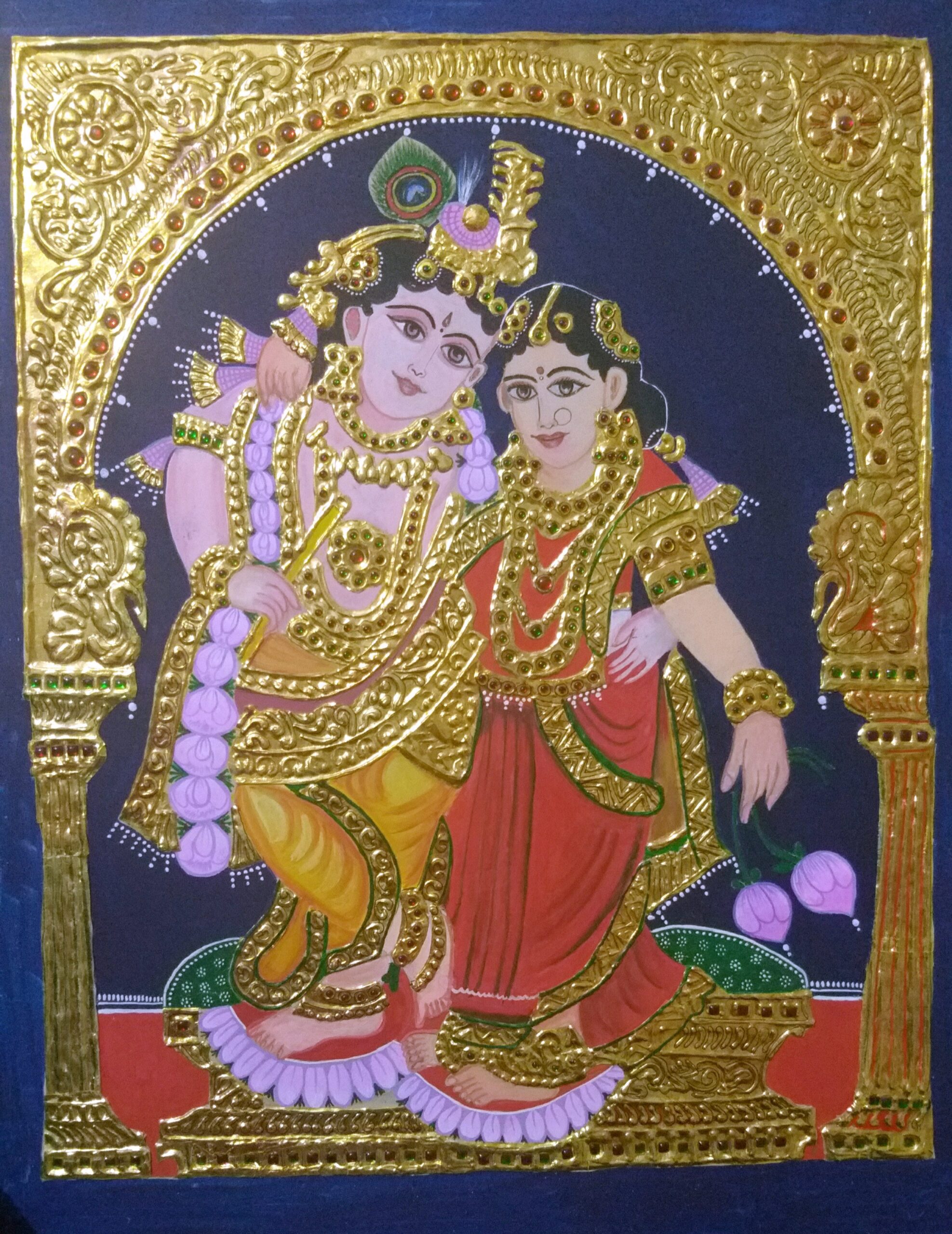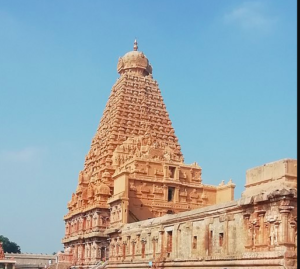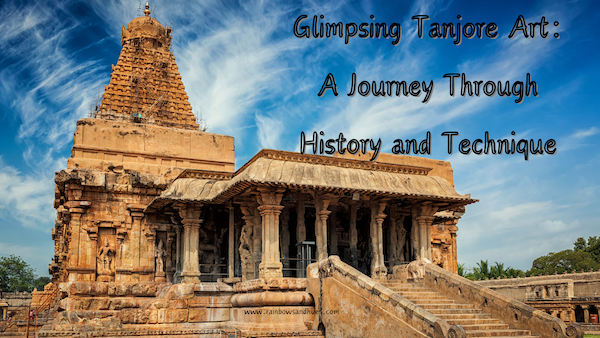Tanjore art, also known as Thanjavur painting, is a classical South Indian art form that originated in the town of Thanjavur (Tanjore) in Tamil Nadu, India. Renowned for its rich colours, intricate details, and ornate compositions, Tanjore art has a long and fascinating history dating back to the 16th century.
Also Read: Ray, Tagore, and Dali: Artists of May
History:
Tanjore art, also known as Thanjavur painting, originated in the town of Thanjavur in Tamil Nadu, India, during the 16th century. Developed under the patronage of the Nayakas of Thanjavur and later the Maratha rulers, Tanjore art reached its zenith during the Chola dynasty in the 17th century. Initially, these paintings adorned the walls of temples, depicting deities and religious themes. Over time, the art evolved to include portraits, landscapes, and scenes from Hindu mythology. Renowned for its rich colours, intricate details, and ornate compositions, Tanjore art continues to be cherished as a cultural treasure of South India.
Famous Facts:
One of the distinguishing features of Tanjore art is its use of rich, vibrant colours and embellishments such as gold foil, glass beads, and precious stones. These materials give Tanjore paintings their distinctive three-dimensional effect and opulent appearance. Another notable aspect of Tanjore art is its portrayal of gods and goddesses with exaggerated features and expressive eyes, conveying a sense of divine majesty and power.

Little Known Facts:
Despite its traditional roots, Tanjore art continues to evolve and adapt to contemporary tastes. Modern Tanjore artists often experiment with new techniques and subject matter while still honouring the traditions of the art form. Additionally, Tanjore art has gained international recognition and appreciation, with collectors and art enthusiasts from around the world seeking out these exquisite paintings.
Also Read: The History and Evolution of Watercolours
Famous Artists:
Several artists have made significant contributions to the field of Tanjore art, showcasing their talent and skill in creating exquisite paintings. Some of the famous Tanjore artists include:
- Raja Ravi Varma: While primarily known for his contributions to the Indian Renaissance movement, Raja Ravi Varma also dabbled in Tanjore painting, infusing it with elements of realism and European techniques.
- M. Narasimhachari: A renowned Tanjore artist, M. Narasimhachari’s works are characterized by their intricate details, vibrant colours, and meticulous craftsmanship.
- A. P. Shreedhara Menon: A prominent contemporary Tanjore artist, A. P. Shreedhara Menon has garnered acclaim for his innovative approach to the art form, incorporating modern themes and techniques while staying true to its traditional roots.
- Vijayalakshmi Navaneethakrishnan: Known for her stunning Tanjore paintings depicting Hindu deities and mythological scenes, Vijayalakshmi Navaneethakrishnan has gained recognition for her exceptional talent and creativity.
- R. Viswam: Renowned for his skilful portrayal of religious themes and cultural motifs, R. Viswam is celebrated as one of the leading Tanjore artists of contemporary times.
Also Read: History of Ganesh Chaturthi Celebration
Temples with Tanjore Art:
Tanjore art, with its rich colors and intricate details, finds prominent display in several temples across South India, particularly in the state of Tamil Nadu. Some of the notable temples that showcase Tanjore art include:
- Brihadeeswarar Temple, Thanjavur: This UNESCO World Heritage Site is not only famous for its architectural grandeur but also for its exquisite Tanjore paintings adorning the walls and ceilings of its sanctum sanctorum. These paintings depict scenes from Hindu mythology and showcase the skill and craftsmanship of Tanjore artists.

- Meenakshi Amman Temple, Madurai: Known for its magnificent gopurams (towering gateways), Meenakshi Amman Temple also features stunning Tanjore paintings that adorn its inner walls and ceilings. These paintings depict various episodes from the life of Lord Shiva and Goddess Meenakshi, adding to the temple’s aesthetic appeal.
- Ramanathaswamy Temple, Rameswaram: This revered temple dedicated to Lord Shiva boasts intricate Tanjore paintings that embellish its corridors and halls. These paintings showcase scenes from the Ramayana, Mahabharata, and other mythological tales, captivating devotees and visitors alike.
- Kapaleeshwarar Temple, Chennai: Situated in the heart of Chennai, Kapaleeshwarar Temple is renowned for its vibrant Tanjore paintings that adorn its inner sanctum and outer walls. These paintings depict various forms of Lord Shiva, Goddess Parvati, and other deities, reflecting the rich cultural heritage of the region.
- Nellaiappar Temple, Tirunelveli: This ancient temple dedicated to Lord Shiva features exquisite Tanjore paintings that adorn its ceilings and pillars. These paintings depict scenes from Hindu mythology, including the divine marriage of Lord Shiva and Goddess Parvati, attracting devotees and art enthusiasts from far and wide.
Also Read: The Artful Dance of Color: An Invitation into the Heart of Color Theory
How Tanjore Art is Done:
Step 1: Preparation of the Canvas
- Raw Materials:
- Wooden base (jackfruit or teak wood)
- Limestone powder
- Adhesive (made from natural ingredients like tamarind seed powder or gum arabic)
- Cloth
- Procedure:
- Cut the wooden base to the desired size and shape.
- Apply a layer of adhesive on the wooden base.
- Spread a mixture of limestone powder and adhesive on top of the adhesive layer.
- Smooth out the surface using a cloth to create a sturdy canvas for the artwork.
Step 2: Sketching the Design
- Raw Materials:
- Charcoal or chalk
- Pencil
- Procedure:
- Sketch the outline of the design directly onto the prepared canvas using charcoal or chalk.
- Use a pencil to add finer details and intricate patterns to the sketch.
Step 3: Painting
- Raw Materials:
- Natural pigments (such as vegetable dyes)
- Gold foil
- Brushes
- Water
- Palette
- Procedure:
- Mix the natural pigments with water to create vibrant colors.
- Paint the base colors onto the canvas, following the outline of the design.
- Allow the paint to dry completely before proceeding to the next step.
- Apply gold foil to specific areas of the painting to add a luxurious touch and highlight certain elements.
Step 4: Embellishment
- Raw Materials:
- Glass beads
- Semi-precious stones
- Adhesive
- Procedure:
- Apply adhesive to the areas of the painting where embellishments will be added.
- Carefully place glass beads and semi-precious stones onto the adhesive, following the design of the artwork.
- Press gently to ensure that the embellishments adhere securely to the canvas.
- Allow the adhesive to dry completely before handling the artwork.
Step 5: Finishing Touches
- Raw Materials:
- Varnish
- Brushes
- Procedure:
- Once the painting is complete and all embellishments are securely attached, apply a layer of varnish to protect the artwork and enhance its appearance.
- Use a brush to evenly coat the entire surface of the painting with varnish.
- Allow the varnish to dry completely before framing or displaying the Tanjore art piece.
Tanjore art is a cherished cultural treasure with a rich history and enduring appeal. Its exquisite beauty, meticulous craftsmanship, and spiritual significance continue to captivate audiences worldwide. Whether displayed in temples, homes, or art galleries, these paintings are timeless reminders of India’s rich artistic heritage and cultural legacy.




